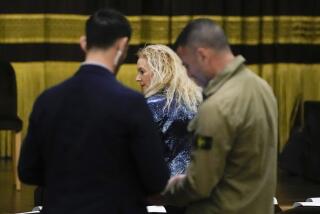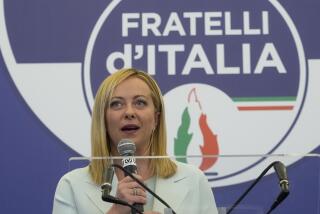Authorities Try to Bring Some Sanity to Zany World of Italian TV
- Share via
ROME — The losing contestant on a game show strips. A gaudy emerald ring fills the screen for hours on end as the price flashes underneath. The host of Italy’s most popular TV program tells his 12 million viewers to turn off their sets for five minutes in a peace gesture.
Welcome to the zany world of Italian TV, perhaps the oddest--some say most watchable--show on Earth.
There are so many TV stations in Italy today that it is almost impossible to keep up with all the talk shows, strip shows, auctions, astrology sessions, documentaries and song-and-dance extravaganzas.
With 1,100 private channels and new stations sprouting up every day, and a high-stakes war raging between state-run and private TV, the government says it is finally close to passing a law to regulate the industry and restore some sanity to the airwaves.
“We’ve been living in Wild West conditions,” said Post and Telecommunications Minister Oscar Mammi. “Now it’s time for the sheriff to step in.”
Italy has undergone a television revolution in the past decade. Color was introduced only 12 years ago, and for years TV-starved Italians, limited to only two state-run channels, set up special antennas to pick up programs from neighboring Switzerland, France and Austria.
All that changed in 1976 when the nation’s Constitutional Court ruled that the state-run RAI network did not have a monopoly of the airwaves, thus opening the door for commercial TV.
Since then, under the guidance of building magnate Silvio Berlusconi, the private Canale 5 network is challenging RAI for ratings supremacy.
Despite a ban on live nationwide broadcasts on private TV, the combined viewing figures for Berlusconi’s three channels--Retequattro, Canale 5 and Italia Uno--often top those of RAI’s three stations during prime time. The private networks tape their shows and deliver the tapes to relay stations around Italy for simultaneous broadcast.
But overall the race is heavily stacked in RAI’s favor. The power of live television is strong: an average of 14 million viewers tune in to RAI Uno’s nightly newscast, and many stick with the station the rest of the evening. RAI runs most of its commercials in a package between programs.
“Together we’re running a 100-meter race. But they (RAI) get a running start while we’re still in the starting blocks,” Berlusconi said. “We have to stop for a commercial every 12 minutes, and we lose 8 to 10% of the viewers at each break.”
Under Mammi’s proposed anti-trust law, Berlusconi would have to drop one of his stations but could broadcast live on the others. One of RAI’s stations would drop commercials altogether. But considering that the government has been promising for 10 years to push through an industry law, there’s no predicting when or if Mammi’s proposal will be approved.
Berlusconi’s channels rely heavily on recycled American fare: soap operas such as “General Hospital” and “Dallas,” cop shows such as “The A-Team” and “Starsky and Hutch,” Hollywood movies and reruns of pro football and basketball games.
Canale 5 also runs countless game and talk shows, including a quiz show run by a man called Mike Buongiorno, and the comedy hit “Drive In,” Italy’s version of the old “Laugh-In” program, replete with a cast of busty women jiggling in skimpy outfits.
The ratings war is waged on one main front: the variety show and its megastar host.
Last year, Berlusconi hired away RAI’s long-reigning king, Pippo Baudo, and made him host of the Friday night program, “Festival.” Baudo was replaced on RAI’s Saturday “Fantastico” program by singer Adriano Celentano, who has embarrassed the network with a series of gaffes and has become a cult hero.
Celentano has attracted between 11 million and 12 million per show, down about 2 million from Baudo’s RAI audience last year. At Canale 5, Baudo’s show averages about 8 million viewers. The two shows, which run for more than three hours, consist mainly of Broadway-style musical sketches and performances by pop singers, stand-up comedians and off-beat entertainers.
The Italian variety show often features Americans. The lead dancer on “Fantastico” is Californian Heather Parisi, discovered by Baudo in a Rome disco, and this fall’s guest stars included a trio of sexy American female pop singers: Apollonia, Vanity and Jill Jones.
“Festival” had Brigitte Nielsen, the estranged wife of Sylvester Stallone.
While Baudo is the archetype of the dapper, professional emcee, Celentano has shaken up “Fantastico” with his unpredictable, irreverent style.
The unshaven host embarrassed RAI on his opening night by pausing interminably between sentences, denouncing his American laundry detergent sponsor and chiding a guest Soviet film director for lack of artistic freedom in the Soviet Union.
On a recent program, he told viewers to turn off their sets for five minutes to show support for the nuclear arms accord signed a few days earlier in Washington. Eight million people, or two-thirds of his audience, dutifully followed the command, according to the nation’s Auditel ratings.
But the wackiest scenes are found on the small private stations.
“Colpo Grosso,” or “Hit It Big,” is a roulette game in which a male and female contestant use their winnings to get studio models to strip--women down to their panties and men to their boxer shorts. If the contestant runs out of money, he or she takes it off.
Switch the channel and you’re likely to encounter a phone-in auction with a ring, a Persian carpet or kitchen utensils for sale. Or you might find furniture salesman Ugo Rosetti, who calls himself mayor of his own TV city and holds televised bikini contests to crown “the world’s most beautiful woman.”
On other channels you can find a fortune teller, a 1960s Italian B-movie, a Brazilian telenovella, music videos and pornography.
More to Read
Sign up for Essential California
The most important California stories and recommendations in your inbox every morning.
You may occasionally receive promotional content from the Los Angeles Times.










